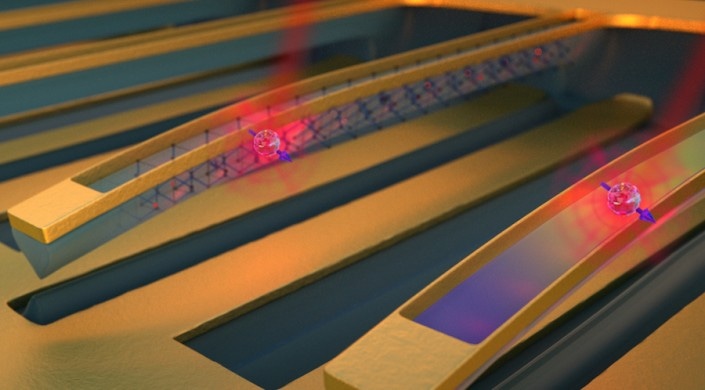May 23 2018
A quantum internet shows potential for totally secure communication. But making use of quantum bits or qubits to convey information requires a fundamentally new piece of hardware—a quantum memory. This atomic-scale device should be able to store quantum information and change it into light to convey across the network.
 Electrodes stretch diamond strings to increase the frequency of atomic vibrations to which an electron is sensitive, just like tightening a guitar string increases the frequency or pitch of the string. The tension quiets a qubit’s environment and improves memory from tens to several hundred nanoseconds, enough time to do many operations on a quantum chip. (Image credit: Second Bay Studios/Harvard SEAS)
Electrodes stretch diamond strings to increase the frequency of atomic vibrations to which an electron is sensitive, just like tightening a guitar string increases the frequency or pitch of the string. The tension quiets a qubit’s environment and improves memory from tens to several hundred nanoseconds, enough time to do many operations on a quantum chip. (Image credit: Second Bay Studios/Harvard SEAS)
A huge challenge to this vision is that qubits are highly sensitive to their environment, even the vibrations of neighboring atoms can disturb their ability to remember information. Thus far, scientists have relied on very low temperatures to subdue vibrations but, realizing those temperatures for large-scale quantum networks is ridiculously expensive.
Now, scientists at the Harvard John A. Paulson School of Engineering and Applied Sciences (SEAS) and the University of Cambridge have come up with a quantum memory solution that is as basic as tuning a guitar.
The team engineered diamond strings that can be tweaked to subdue a qubit’s environment and enhance memory from tens to several hundred nanoseconds, adequate time to perform many processes on a quantum chip.
Impurities in diamond have emerged as promising nodes for quantum networks. However, they are not perfect. Some kinds of impurities are really good at retaining information but have a hard time communicating, while others are really good communicators but suffer from memory loss. In this work, we took the latter kind, and improved the memory by ten times.
Marko Loncar, Tiantsai Lin Professor of Electrical Engineering at SEAS & Senior Author
The study is reported in Nature Communications.
Impurities in diamond, called silicon-vacancy color centers, are strong qubits. An electron captured in the center serves as a memory bit and can discharge single photons of red light, which would, in turn, serve as long-distance information carriers of a quantum internet. But with the neighboring atoms in the diamond crystal vibrating haphazardly, the electron in the center rapidly forgets any quantum information it is expected to remember.
“Being an electron in a color center is like trying to study at a loud marketplace,” said Srujan Meesala, a graduate student at SEAS and the paper’s co-first author. “There is all this noise around you. If you want to remember anything, you need to either ask the crowds to stay quiet or find a way to focus over the noise. We did the latter.”
To enhance memory in a noisy environment, the team carved the diamond crystal housing the color center into a thin string, approximately one micron wide - a hundred times thinner than a strand of hair - and fixed electrodes to either side. By applying a voltage, the diamond string stretches and increases the frequency of vibrations the electron is sensitive to, just like when a guitar string is tightened, the frequency or pitch of the string increases.
By creating tension in the string, we increase the energy scale of vibrations that the electron is sensitive to, meaning it can now only feel very high energy vibrations. This process effectively turns the surrounding vibrations in the crystal to an irrelevant background hum, allowing the electron inside the vacancy to comfortably hold information for hundreds of nanoseconds, which can be a really long time on the quantum scale. A symphony of these tunable diamond strings could serve as the backbone of a future quantum internet.
Srujan Meesala, Graduate Student at SEAS & Co-First Author
Going forward, the scientists hope to spread the memory of the qubits to the millisecond, which would allow numerous operations and long-distance quantum communication.
The Harvard Office of Technology Development has protected the intellectual property concerning this project and is looking at commercialization opportunities.
The research paper was co-first authored by Young-Ik Sohn and Srujan Meesala from Marko Loncar’s group at Harvard, and Benjamin Pingault from Mete Atature’s group at the University of Cambridge. Researchers from Harvard SEAS, Harvard Physics, and Sandia National Laboratories also contributed to the manuscript.
The study received support from the National Science Foundation-sponsored Center for Integrated Quantum Materials, Office of Naval Research Multidisciplinary University Research Initiative on Quantum Optomechanics, NSF Emerging Frontiers in Research and Innovation ACQUIRE, the University of Cambridge, the ERC Consolidator Grant PHOENICS, and the EPSRC Quantum Technology Hub NQIT.